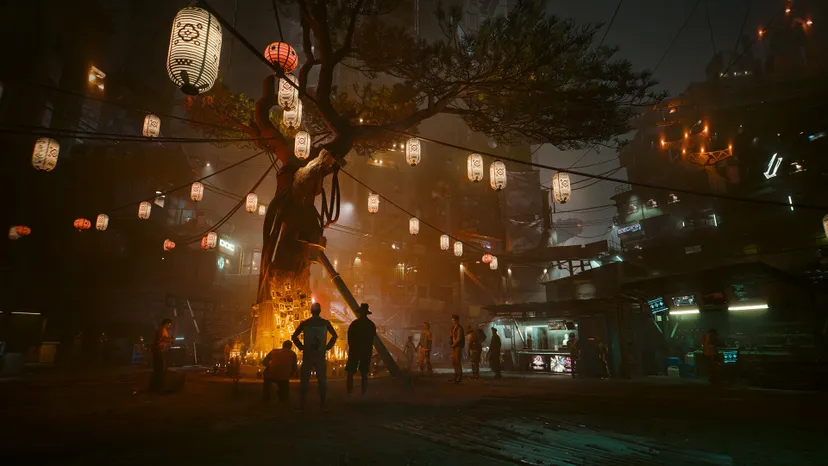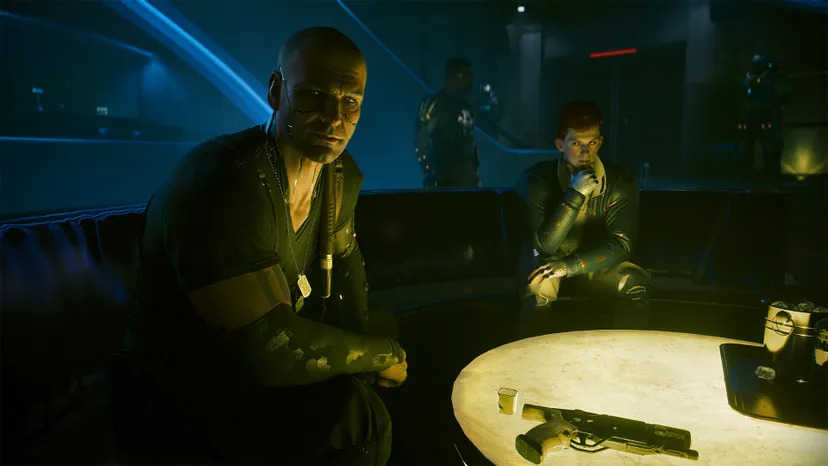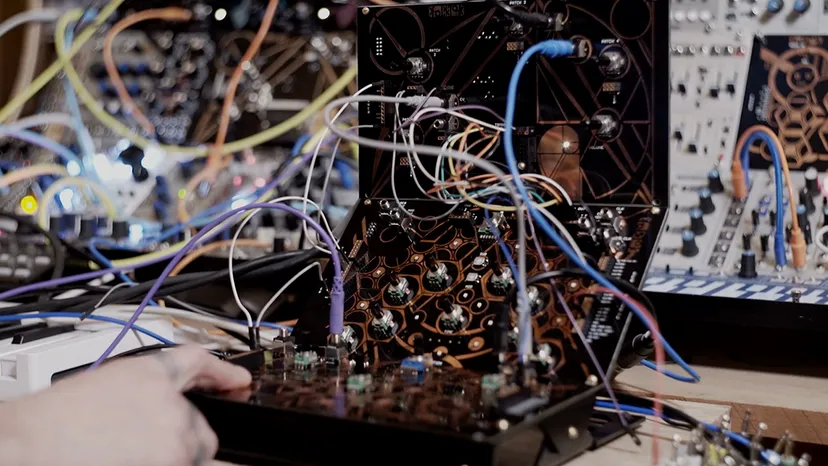“This time round, we have been coping with a smaller and far more centered story. Though we have been making a spy-thriller story, it was important for me to convey out colours and feelings that went past what you would possibly affiliate with a narrative on this style,” explains CD Projekt Purple (CDPR) senior composer P.T. Adamczyk, discussing how he started creating the soundscape for Cyberpunk 2077’s blockbuster growth pack, Phantom Liberty.
Adamczyk helped create the authentic rating for the acclaimed growth–which plunges protagonist V into the center of a high-stakes story of espionage centered across the NUSA president, netrunner Track So Mi (a.okay.a. Songbird), and undercover agent Solomon Reed—alongside fellow CDPR composer Jacek Paciorkowski.
Throughout an e-mail interview with Sport Developer, Adamczyk and Paciorkowski clarify that crafting the music for Phantom Liberty was much less about slavishly accommodating that delicate style shift and extra about serving to gamers join with a brand new solid of characters by scoring for empathy.
“It was essential for me to start out with a bit that would play beneath each So Mi and Reed and provides the gamers extra context about their shared previous and the unlucky scenario they discovered themselves in,” he explains. Adamczyk notes that the tone of the sport was already established because of his work on Cyberpunk 2077, so iterating on that rating “was extra about discovering the suitable [colors] from the already current palette.”
He additionally says that engaged on the unique title left him feeling extra assured about scoring Phantom Liberty‘s extra interactive scenes, given he’d already been by means of that course of with the remainder of the CDPR staff. “With the assistance of our nice Tech Music Designer, Piotr Czub, we have been in a position so as to add far more dynamic music to the kind of scenes which we’d rating with a static loop within the base sport,” he provides.
Narrative beats are your musical North Star
Breaking down his wider philosophy and workflow with regards to scoring an enormous venture like Phantom Liberty—which price CDPR round $85 million to create and market—Adamczyk says the method all the time begins with a basic recognizing session.
“We undergo every quest of the sport and attempt to perceive the wants of the general story in addition to particular story beats. As soon as we’ve got that understanding, we begin tackling particular person cues, starting with those which can be crucial for the story, like essential dialogue cues and set items. This enables us to spend extra time on pivotal and defining moments of the story which is able to later affect the neighboring cues,” he continues.
“As for the writing course of itself, it’s all the time a thriller. Clearly, having the chops from the bottom sport might help, however it can also lead you down a overwhelmed path, which is one thing it’s best to attempt to keep away from. With Phantom Liberty, I began with a piano motif which grew to become the So Mi and Reed theme. I wished to write down a nocturn-esque piece which might give me the baseline underscoring their previous relationship, which influenced their choices introduced within the story.”
Paciorkowski echoes these remarks, noting that recognizing was a “basic a part of the method.” He explains it permits him to generate preliminary concepts for tracks and motifs, offering him with an area to experiment and freely mix concepts whereas holding particular person scenes and visible cues firmly in thoughts.
“As a rule, I’d overdo it, however that’s when playthrough periods turn out to be useful. It’s additionally once I can begin the method of discarding parts that I don’t actually need. For instance, with ‘Infiltration Compromised’ I began off with an over-the-top banger, anticipating that the ultimate form of the fight scene could be extra intense. By sculpting away on the observe, I managed to take care of its core vibe and make it match higher the actual depth of the second,” he provides.
Scoring is about collaboration and experimentation, not micro-management
Latching onto Paciorkowski’s want to experiment, we ask the duo what it is like collaborating with the remainder of the staff at CDPR. Adamczyk claims they’re each “very lucky” to work in an surroundings the place they’re given nearly whole artistic management over the musical facet of the venture, and notes that even after they do obtain suggestions, these critiques come from a “collaborative perspective moderately than from a micro-managerial mindset.”
Paciorkowski explains that though the music staff is given artistic management, they like to achieve out for suggestions frequently. “If you’re amongst like-minded folks, you’re probably not restricted; you’re empowered to create one thing nice. Internally, throughout the music staff, we attain out for suggestions always. None of us are writing in a void,” he says.
“Working proactively like this all the time helps not solely the higher collaborative course of, however lets us set up smoother music narration from the beginning. On high of that, with regards to the entire Phantom Liberty improvement staff, I’ve by no means seen such a focus of expertise and uncooked power on a venture. Whenever you’re amongst such folks you are inclined to develop belief each methods after which magic occurs.”

After all, the power to tinker with out prying eyes is a commodity value its weight in gold, letting each Adamczyk and Paciorkowski play quick and free with the ‘guidelines’ of digital music to create one thing that warps expectations. “The largest experiment was having the vocal trio Tulia being ‘the sound of the Blackwall’. It’s not a typical combine, to have Jap European people singing blended with our model of techno-inspired, hard-hitting digital music,” says Adamczyk. “However I believe this distinction and the sheer energy of their voices create an fascinating coloration. It highlights the ability and uncontrollable high quality of the issues behind the Blackwall. By being so distinct from the remainder of the rating, it allowed us to make use of these voices nearly like a theme itself which created an fascinating layering of that means in lots of scenes.”
Paciorkowski additionally sought to harness the “uncooked” nature of Adamczyk’s synthesizer, which featured closely on the rating for Cyberpunk 2077, to create sudden outcomes with out departing an excessive amount of from that acquainted “Cyberpunk sound” gamers have come to affiliate with the franchise. “[The synth didn’t come with a] guide as a result of the producer encourages experimentation, and at occasions it could sound too uncooked, however with just a little publish processing and an entire lot of experimentation, something may be created—from lengthy ethereal pads and rhythm sequences to punchy and gritty bass traces,” he explains.
Neon conversations and phantom futures
Earlier on in our chat, Adamczyk says that creating music able to supporting and enhancing the dialogue in Phantom Liberty was an enormous consideration. Though he baked this requirement into the method from the very starting, delivering on that promise was nonetheless a colossal problem.
“For essentially the most half, we don’t have conventional cutscenes in Cyberpunk 2077, so the participant’s actions are one thing we all the time have to contemplate,” he explains. “That is why we bounce our cues into small segments, generally even 2-3 bars lengthy, to ensure there’s sufficient granularity within the implementation. It lets us actually sync our rating to the occasions on display screen. I really feel that with a number of the scenes from Phantom Liberty, we topped what we did within the base sport.”
Discussing their private Everest, Paciorkowski explains that whereas knitting collectively an interactive soundscape permits him to shun linearity and chart sudden paths, it additionally presents an extremely area of interest problem as a result of it’s important to think about a myriad variables. “On the one hand, interactive music provides me a possibility to make use of what in any other case wouldn’t match right into a linear piece. I all the time have too many concepts. Generally part of me is in a temper that’s utterly reverse to the remaining, or I’ve 2-3 ranges of depth in a section that I can not resolve on, and the small segments we use make it potential to suit greater than you possibly can in a conventional track,” he says.

“However then again, that is the place the problem is available in: ensuring all the things works collectively musically, determining the most effective moments for transitions, and most significantly, ensuring the music is synced to what’s occurring on the display screen may be daunting. Luckily our tech wizard Piotr Czub was all the time there to assist our imaginative and prescient come to life.”
These weren’t the one strain factors. Adamczyk explains that one of many extra fiddly challenges of engaged on a heavy, digital rating was making an attempt to work round a set BPM bolstered by a pounding kick drum. He describes that exact hurdle as being “actually troublesome” to beat.
Paciorkowski elaborates, explaining the perceived confines of the style compelled the composers to reconcile themselves with a “conflict of worlds” that you just won’t encounter when working inside a extra standard musical area. “When scoring video games or a movie, a composer can use highly effective weapons similar to intricate particulars that flippantly underscore the scene or a tempo/signature change to create some motion,” he provides. “Alternatively, heavy digital membership music is all a couple of regular and heavy groove inducing a trance-like state that retains you kind of emotionally on the identical degree. Determining methods to mix these two approaches was definitely the largest problem for me.”
The gear behind Cyberpunk 2077: Phantom Liberty
Earlier than we proceed discussing the rating, we ask Adamczyk and Paciorkowski to take us on a digital tour of their studio and clarify which instruments have been completely indispensable when engaged on Phantom Liberty. Adamczyk explains they surrounded themselves with lots of gear made by SOMA Devices, together with their Pulsar-23—which he describes as a “spectacular drum machine” and options on quite a lot of tracks together with ‘Apex Predators.’
“The Pipe [by SOMA], which is a vocal processor, allowed me to report some vocal textures myself—though I’m a horrible singer. I additionally used it to course of Tulia’s voices. You’ll be able to hear the consequences within the observe ‘By no means Wanting Again’ or ‘Gate K9,'” he says. “[I also used the SOMA] Ether, which is a wide-band receiver that interprets the electromagnetic discipline into audio, was extremely useful in creating lots of the drone sounds.
“I mainly took Ether, plugged it into my moveable recorder, and walked across the CDPR campus catching sounds made by all the things—from screens to air con models. The outcomes may be heard within the opening observe of our rating in addition to in “On the Prowl”, which performs each time V is sneaking previous Barghest troops.”

The Folktek Mescaline v2 appears suitably Cyberpunk
Paciorkowski’s go-to synth was the Folktek Mescaline v2 he talked about earlier, which enabled him to create an immediate “Cyberpunk 2077 vibe” in a snap. He additionally had the chance to make use of the Motor Synth by Gamechanger Audio, which belongs to authentic Cyberpunk co-composer Marcin Przybyłowicz and is described as an “odd-looking electro-mechanical contraption that makes use of rotating discs as oscillators.” Paciorkowski says scoring Phantom Liberty was his first time recording a synth in an electroacoustic method, with these rotating discs getting used to create further harmonics that he captured along with his Rode NT-1A mic.
“There have been fairly a number of dialogue scenes the place I’d use a gradual arp from Motor Synth with an acoustic layer barely blended in so as to add harmonics. Final however not least, there’s the Shruthi One by Mutable Devices, a DIY synth that has been with me for years now,” he continues. “Most of my bass traces have been created with it in addition to Severins’ arp that went by means of an Alesis delay and Analog Drive by Elektron to offer it some heat, coloration, and house. On the Elektron observe, being a very unhealthy drum programmer, I like utilizing Digitakt each time I have to create a fast drum groove to jam to on the fly.”
Themes are your connective tissue
One essential side of delivery any online game is figuring out when to step away. Creativity is a means of fixed iteration, however which means our want to tweak and hone seeking perfection may be debilitating if left unchecked. How have you learnt when to set your self free? Adamczyk says it is about trusting your instinct.
“We play the sport lots and we examine our work often. If a scene rubs us the incorrect method, we’ve got to make adjustments. However why it occurs, I actually don’t know. I suppose, on the finish of the day, we’re additionally avid gamers and viewers members and we simply attempt to make issues that we’d get pleasure from ourselves,” he explains.
Paciorkowski generally discovered it more durable to let go, noting that even when different members of the staff have been completely satisfied along with his cues he nonetheless felt compelled to work on them just a little longer. “I’d return to them and re-iterate. Most frequently this might be my course of—iterating on the preliminary thought till I really feel utterly glad with the scene,” he defined. There have been, nonetheless, different events when all the things merely fell into place from the beginning and a bit of music would immediately mesh with the gameplay expertise.” In the end, Paciorkowski agrees that it is all about instinct—however which means it is about trusting your self to know when one thing merely “feels proper.”
The overwhelmingly optimistic reception Phantom Liberty has garnered means that each composers—and the remainder of the CDPR staff—have discovered methods to land on that candy spot. By following their instincts and leaning into Phantom Liberty’s extra concise narrative, Adamczyk feels the staff was in a position to imbue the rating with particulars and layers that merely weren’t current in the principle sport.
He says that is evidenced at first of Phantom Liberty when the observe ‘I am a Netrunner’ kicks in, subtly teeing up the So Mi and Reed themes that may come to outline these particular characters. There’s one other cue that eager listeners would possibly discover in ‘Simply One other Weapon,’ which performs when V, Songbird, and Reed first meet nose to nose. That sonic tidbit additionally underscores a pivotal second on the ending of the sport, referencing a future that has but to go.
“I’m pleased with how all of those scenes turned out,” says Adamczyk. “All of them use the identical thematic materials and I believe that creates extra attachment to the characters, and due to this fact makes the entire gaming expertise far more pleasing.”


